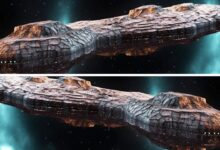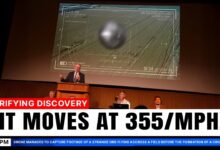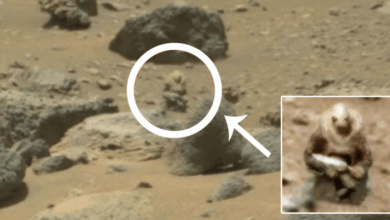Scientists Opened Pyramids Hidden Chamber, What They Found Is Much Worse
Unveiling the Hidden Secrets of the Great Pyramid of Giza: A New Era of Exploration
The Great Pyramid of Giza, an ancient marvel of engineering, continues to amaze the world with its mysteries. Despite being one of the most extensively studied monuments in history, the pyramid’s interior still holds surprises, thanks to the advent of advanced scanning technologies. The latest revelation—a hidden corridor stretching over 100 feet—was concealed for over 4,500 years and only uncovered through groundbreaking technologies like muon tomography. This discovery has reshaped our understanding of the pyramid’s construction and its structural complexities, opening new doors for future exploration.
The New Hidden Corridor: A Monumental Discovery
The newly discovered corridor is located above the Grand Gallery and just behind the northern face of the pyramid. While it doesn’t contain treasure or inscriptions, its existence adds a fascinating new dimension to the pyramid’s internal architecture. The corridor’s gabled ceiling suggests a structural purpose, possibly designed to alleviate the weight from the descending corridor below. The use of advanced non-invasive methods like muon tomography allowed scientists to detect this hidden space without damaging the pyramid, offering an unprecedented look into its inner workings.
The fact that this corridor was concealed for millennia further underscores the extraordinary engineering skills of the ancient Egyptians. While it doesn’t dramatically change our understanding of Egyptology, it deepens our appreciation for the ingenuity involved in constructing such a massive and precise structure. The discovery confirms that the pyramid’s design is far more complex than previously thought, highlighting the sophistication of ancient Egyptian builders and their understanding of structural mechanics.
Muon Tomography: The Technology Behind the Breakthrough
Muon tomography, the technique used to uncover this hidden corridor, relies on the detection of cosmic particles known as muons. These particles penetrate solid objects and provide detailed scans of their internal structures, much like an X-ray. Muons are ideal for scanning dense materials like stone, making them perfect for exploring the interior of ancient monuments such as the Great Pyramid. This technology, combined with infrared thermography, allowed researchers to uncover hidden voids and spaces within the pyramid without causing any physical intrusion, marking a significant leap forward in archaeological exploration.
The ability to detect hidden voids non-invasively is a game-changer for the field of archaeology. It opens up new possibilities for studying ancient monuments and gaining insights into the methods used in their construction. As the technology advances, the potential for discovering even more hidden chambers or passageways inside the pyramid grows, suggesting that there is still much to be learned about this ancient wonder.
The Big Void: A Larger Mystery
Beyond the newly discovered corridor, the “Big Void” remains one of the most intriguing finds inside the Great Pyramid. Detected through scans in 2017 as part of the Scan Pyramids project, the Big Void measures approximately 30 meters in length. Despite being identified, its exact nature remains a mystery. Some researchers speculate that it could be a construction feature, such as an internal ramp used during the pyramid’s construction. Others entertain the idea that it could be a hidden chamber, potentially holding artifacts or even offering clues about the pyramid’s purpose and the reign of Pharaoh Khufu.
Accessing the Big Void presents a significant challenge. While the North Face Corridor was successfully probed in 2023, the Big Void is much deeper inside the pyramid, making direct inspection difficult. To explore this space, scientists would need to drill through several meters of solid stone, a task that requires careful planning and approval. However, the potential discoveries within the Big Void continue to captivate the imagination of Egyptologists and archaeologists.
Expanding the Search: Other Pyramids and Anomalies
The Scan Pyramids project has also extended its scanning technology to other pyramids in the Giza complex, such as the pyramids of Khafre and the Bent Pyramid at Dashur. While no discoveries on the scale of the Big Void have been reported, the potential for hidden features in these pyramids remains. The Bent Pyramid, in particular, offers a fascinating case study. Its distinctive change in angle mid-construction suggests that internal spaces might have been adapted or sealed off during the building process. This anomaly could point to undiscovered chambers or passageways within the structure.
Additionally, theories have emerged suggesting that underground tunnel networks might connect the pyramids beneath the Giza plateau. These claims, based on synthetic aperture radar analysis, propose formations hundreds of meters deep, though they remain unverified and face skepticism from the academic community. Regardless, the possibility of hidden tunnels adds another layer of intrigue to the already mysterious landscape surrounding the pyramids.
The Future of Pyramid Exploration: Advancing Technologies
As technology continues to advance, the potential for new discoveries within the Great Pyramid and other ancient Egyptian monuments grows. Researchers are now focused on refining existing methods and developing new tools to explore the pyramid’s interior more thoroughly.
One of the next steps is to further investigate the North Face Corridor. While endoscopic technology provided valuable insight in 2023, there is still much to learn about the corridor’s full extent. The goal is to deploy steerable endoscopic devices capable of mapping the entire interior, analyzing floor debris, and identifying any hidden markings or inscriptions that might shed light on the pyramid’s construction.
For the Big Void, refined muon tomography remains one of the best non-invasive methods to reveal its secrets. Scientists hope to create a more detailed 3D density map of the pyramid’s interior, allowing them to discern the void’s exact shape and potentially uncover artifacts or structural features within it. This approach could provide a clearer picture of how the pyramid was built and its true purpose.
Robotics: Exploring the Uncharted Depths
The development of micro-robotics is another exciting frontier in pyramid exploration. Researchers are working on designing tiny, agile robots capable of navigating the pyramid’s narrow and complex internal spaces. These robots could be used to explore hidden voids, such as the NFC or Big Void, by sending back images and data from within the pyramid. The possibility of these robots drilling small, minimally invasive holes to access previously inaccessible chambers could revolutionize how we study ancient monuments.
The idea of tiny robots venturing into the Big Void, capturing the first images from this vast, hidden space, is both thrilling and tantalizing. While this technology is still in the experimental stages, it represents a promising new approach to exploring the pyramid’s secrets without causing any harm to the structure.
The Road Ahead: Unlocking the Pyramid’s Final Secrets
The Great Pyramid of Giza is far from giving up all its secrets. With each new discovery, our understanding of the pyramid’s construction and purpose continues to evolve. The combination of advanced scanning techniques, robotics, and growing technological capabilities promises to unveil even more hidden chambers, passageways, and insights into the ancient Egyptians’ unparalleled engineering skills.
As the journey to uncover the pyramid’s full story continues, each breakthrough serves as a reminder that the mysteries of ancient Egypt are far from being solved. The Great Pyramid may be 4,500 years old, but its secrets are still waiting to be discovered, offering us a deeper connection to the brilliance of the ancient builders who created it. The future of pyramid exploration is limitless, and each new discovery adds another chapter to the fascinating story of one of the greatest structures ever built.




